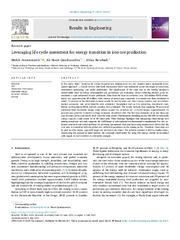| dc.contributor.author | Pouresmaieli, Mahdi | |
| dc.contributor.author | Nouri, Ali | |
| dc.contributor.author | Barabadi, Abbas | |
| dc.date.accessioned | 2025-08-25T13:20:24Z | |
| dc.date.available | 2025-08-25T13:20:24Z | |
| dc.date.issued | 2025-07-14 | |
| dc.description.abstract | In this study, titled “Reducing the Carbon Footprint of a Medium-Scale Iron Ore Complex with a Sustainable Development Approach”, a Cradle-to-Gate Life Cycle Assessment (LCA) was conducted across the stages of extraction, concentrate processing, and pellet production. The significance of the topic lies in the mining industry's considerable share in energy consumption and greenhouse gas emissions, where achieving climate goals necessitates a rapid reduction of such pollutants. Data from the base year showed over 320 million KWh of electricity and approximately 85 million cubic meters of natural gas consumed. A scenario was then simulated in which 70 percent of the electricity demand would be met by solar and wind energy sources, and its environmental, economic, and social benefits were calculated. Parameters such as CO₂ reduction, investment costs, Return on Investment (ROI), and job creation were evaluated. The results indicate that supplying 70 percent of electricity from renewable energy could reduce annual CO₂ emissions by >123,000 tonnes (approximately 25 percent) and generate economic savings of around 34 million USD. The ROI was estimated to be less than one year for solar power and nearly three years for wind power. Furthermore, installing nearly 100 MW of renewable energy capacity could create 20 to 50 direct jobs. These findings highlight that integrating clean energy into mining complexes not only supports the fulfillment of international environmental commitments but also enhances economic and social resilience by lowering operational costs and increasing employment. Given that the data used is consistent with the global rate without dependence on the mining sector. Therefore, these data can be used in other mines, especially large and medium-scale mines. The point to consider is that in smaller mines, considering the amount of mine income, the economic justification for using this energy should be examined with regard to cost variables in renewable energies. | en_US |
| dc.identifier.citation | Pouresmaieli, Nouri, Barabadi. Leveraging Life Cycle Assessment for Energy Transition in Iron Ore Production. Results in Engineering (RINENG). 2024 | en_US |
| dc.identifier.cristinID | FRIDAID 2392459 | |
| dc.identifier.doi | 10.1016/j.rineng.2025.106195 | |
| dc.identifier.issn | 2590-1230 | |
| dc.identifier.uri | https://hdl.handle.net/10037/38022 | |
| dc.language.iso | eng | en_US |
| dc.publisher | Elsevier | en_US |
| dc.relation.journal | Results in Engineering (RINENG) | |
| dc.rights.accessRights | openAccess | en_US |
| dc.rights.holder | Copyright 2025 The Author(s) | en_US |
| dc.rights.uri | https://creativecommons.org/licenses/by/4.0 | en_US |
| dc.rights | Attribution 4.0 International (CC BY 4.0) | en_US |
| dc.title | Leveraging Life Cycle Assessment for Energy Transition in Iron Ore Production | en_US |
| dc.type.version | publishedVersion | en_US |
| dc.type | Journal article | en_US |
| dc.type | Tidsskriftartikkel | en_US |


 English
English norsk
norsk
